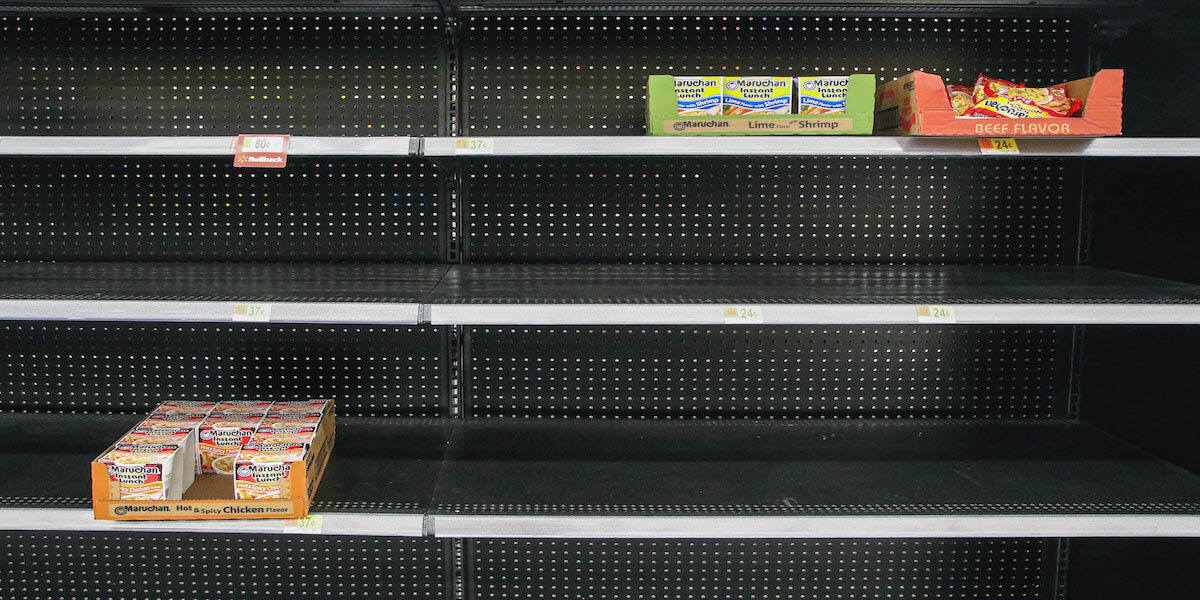 Albert Nombres
Albert Nombres
COVID-19: Supply Chain and The Great Disruption
In light of COVID-19's massive disruption of our global economy and daily lives, it is more important than ever to enable fully digital and data-driven supply chains.

The COVID-19 pandemic has already resulted in more than 2.5M cases and 170k deaths globally, as we speak. The deaths are in many cases a result of overwhelmed hospital capacity, specifically in matching the supply of test kits, personal protective equipment (PPEs), intensive care unit (ICU) beds and ventilators to the increasing demand, especially for critical cases. This gives us a powerful lesson of how COVID-19 significantly impacts many supply chains, whether for those producing essential products, services, or both.
As we have already witnessed in past weeks, countries and firms continue to face severe shocks to their logistics and they will scramble to enact contingency plans in the short term. The question is how we effectively respond to such a crisis immediately. Now let us consider:
- When China faces a manufacturing disruption does the rest of the world seize up? Over the last decade, the world has become increasingly globalized, with heavy dependence on China. This has led to the creation of large, complex and sophisticated supply chains.
- Efficiencies in supply chains have come through the application of lean methods and the associated just-in-time inventory policies used to enable low inventory, high service level operational execution.
- These supply chains are fragile. They work well during most normal operating conditions but suffer greatly when faced with significant disruptive events. COVID-19 is proving to be among the greatest of logistics disruptors in modern times.
COVID-19 vs SARS
The current COVID-19 outbreak is a unique disruption event in that the onset was rapid. It effected both demand and supply on a global level. Many analysts draw parallels between the current pandemic and the SARS epidemic which struck in 2002/2003. However, this is misleading. SARS was contained within Asia for the most part, resulting in 8000 cases worldwide. COVID-19, as of April 2020, has resulted in 1.8 million cases and continues to increase at an exponential rate. During SARS, China accounted for 4.31% of the worlds GDP. Currently China represents 16% of the worlds GDP. In addition, COVID-19 is spreading unchecked across the United States, Japan, Germany, India, France, the UK, Italy and Spain which, when combined, account for 48% of the world’s GDP.
Face Masks and Toilet Paper
Let us consider a very familiar example. During the early stages of the COVID-19 crisis in early January, many people were looking to buy face masks. The problem was they were already out of stock. This was before the crisis had officially reached pandemic proportions, but the signs were there. Then fear set in, and the need to find face masks as they got scarcer. The question is: why are people panic buying and what does this do to the supply chain?
The psychology of a panic buy is rooted in human nature. It is driven by a contagious fear of not having access to things we consider essential (e.g., face masks, hand sanitizer, thermometers and toilet paper, etc., in the case of COVID-19) during a time of crisis. It leads to (entirely avoidable) shortages caused by extreme increases in demand over a short period of time which puts immense strains on fragile supply chains. Think of those empty supermarket shelves when the quarantine measures were announced, and you can see what I mean.
Toilet paper demand swelled to unforeseen levels in March with $1.45 billion dollars in sales in the four-week period ending on March 29th, up 112% year over year. The demand emptied shelves faster than retailers could restock them. This surge in demand has led to higher retail prices with some prices reaching double.
Speaking of extreme demand increases over a short period of time, this is what it looked like for toilet paper: In 2019, toilet paper sales for March were $684 million; in 2020, March sales hit $1.45 billion.
That extreme increase (~845%) from March 11-12 was triggered by consumer panic buying and hoarding behavior.
How can we respond to such a situation? We should provide visibility to consumers on stock locations and availability, we should centralize control of the distribution of essential items and limit the quantities that can be acquired. But, can this be done at scale?
Taiwan's Response to Face Mask Supply
Yes, it can, and it is exactly what Taiwan did with face masks. They built and deployed a smartphone application which showed users mask availability across different locations. It also allowed them to buy a pre-determined numbers of face masks per week. The information was shared between retailers, manufactures and health care agencies coordinating the crisis response.
Their solution addressed a few drivers.
- It alleviated the sense of panic around getting face masks, which in turn negated the near instantaneous extreme increase in demand. This allowed for additional face mask manufacturing capacity to be added and supply to be increased gradually.
- It allowed for safer access to face masks as people don’t have to queue for hours in large groups to get face masks.
- It enabled efficient redistribution of masks across the country to where they were needed most, as you could see where people were searching for face masks based on the app and where stocks were low and restock accordingly.
- The solution had the additional benefit of stopping hoarding of face masks by guaranteeing the availability of a set number of face masks during a fixed period (three face masks per adult per week, which was increased to five as more face masks were produced).
Taiwan was able to use a technology-enabled supply chain solution at scale to add resilience to a fragile supply chain. They have been so successful in their efforts that they are now able to supply face masks to other countries in need during this crisis.
Can we achieve the visibility, efficiency and control needed to stabilize the supply chain? Large retailers routinely manage stock in partnership with their suppliers; eCommerce companies have the operational expertise to manage inventory at scale; pharmaceutical companies have the technical skills needed for drug delivery across their supply chains; and insurance agencies, clinics and pharmacies all have electronic patient management systems.
The Digital Supply Chain (Supply Chain of the Future)
COVID-19 is not only exposing the flaws of existing logistics processes, it is demanding and, perhaps to some extent, even forcing firms and processes to shape up, or otherwise go extinct. Disruption affects the whole process chain – from raw material producers, to factories, to shippers, distributors, delivery personnel, and ultimately, the end consumer. We have witnessed how this pandemic and resulting lockdowns led to factory closures, the loss of millions of jobs and a spiraling global economy.
The good news is there are so many advances in data science, advanced analytics and information and communications that enable a supply chain company to become fully digital and data-driven, and to adapt to the changing landscape brought on by the pandemic.
So, what is a Digital Supply Chain (or Supply Chain of the Future)?
- All the elements of a fully digital supply chain are aligned to a central business strategy, which include provisions for risk management and business continuity, are able to anticipate major disruptions (both long term and short term), and have the resiliency and flexibility to adjust on the fly, mitigate the impacts and quickly recover back to normal flow.
- A fully digital supply chain is able to harness the power and advances in information and communications, including 5G, IoT, AI, AR & VR, to support platforms and applications that intelligently track and monitor inventory information and condition of goods from different parts of the supply chain via sensors and smart phones at different points in the distribution network.
- Based on data-driven analytics, a digital supply chain provides visualization and insights that give answers, trends and predictions to both supply and demand situations, prescribes the next best actions, and ultimately solve logistics business problems. All this while the system is continuously self-learning to improve the process and outcome.
Necessity is the mother of all invention. What we need is to wed all the new technology and advancements (led by 5G and IoT) and the supply chain to address challenges quickly.
Let’s go back to the ICU bed supply and demand situation as an example …
Currently, there is a projected need for 18,286 ICU beds to treat COVID-19 patients in the United States, reflecting a potential shortage of 9344. This number will change as the pandemic spreads. If preventative measures are successful in slowing the transmission rates this demand will be spread over a longer period enabling health care networks to not be overwhelmed. This is what is known as flattening the curve.
However, even if the COVID-19 spread is slowed down, depending on the percentage of the population infected and the period over which this happens (6-12-18 months), hospitals would still have to increase their critical care capacity between 1.5x to 11x of what is currently available. While we may be able to address the equipment shortages, it will be more challenging to address manpower shortages as there is a dearth of health care professionals trained to provide care for critically ill patients.
Addressing this human supply chain will prove more challenging than the material supply chain as it takes longer to acquire competency in a complex new skill than it does to manufacture the equipment.
We would need to focus on a few key areas in order to address the challenges:
- We must monitor and safeguard the health of the critical healthcare professionals as they are essential to our ability to respond to COVID-19. They also, by the nature of their work, run the highest risks of contracting the disease through repeated exposure. We could use wearable technology tagged to smart devices to take periodic, temperature and heart rate readings and to track sleep. This is where 5G and IoT becomes very useful.
- We must devise ways to rapidly upskill existing healthcare professionals to be able to provide care to critically ill patients. We can deploy technology such as augmented reality (AR) and virtual reality (VR) to allow remote monitoring and management of more patients.
- We must standardize the equipment and increase the level of intelligence (automation) within the equipment. This is to enable increased manufacturing output, efficient operations in the field and, most importantly, rapid ability to train professionals on standard equipment.
- Finally, we should centralize the care for COVID-19 patients in healthcare hubs where possible. This will allow for efficient deployment of scarce specialist equipment and health care professionals.
In Summary
The COVID-19 pandemic has exposed some failures in many supply chains, including vulnerabilities within our social and economic networks. We need to bring people, processes and technology together to find creative solutions to address those concerns and also capitalize on the new opportunities they bring. In each of these examples, we discussed the fragility of logistics. We can see the advantages offered by digitization and how it creates resilience and flexibility. Logistics digitization is no longer a nice to have feature. It is now a must-have in order to survive and thrive in this new reality. At Teradata, we help transform supply chains through the power of data and analytics, so that people can live better lives. COVID-19 and “The Great Disruption” are no exception.
알고 있어
테라데이트의 블로그를 구독하여 주간 통찰력을 얻을 수 있습니다
